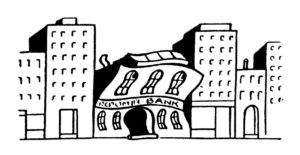“Making Art with Failed Banks”
By Mark Singer in the September 26, 2016 Issue
Michael Mandiberg, an artist whose preoccupations merge digital information with visual representation, has a lot going on. This was also the case eight years ago, when he lived in Brooklyn (Prospect Heights, still does) and was a senior fellow at Eyebeam, a nonprofit that supports artists immersed in technology and playful technologists. “I was noticing that people were giving away books, streeting them, leaving them on stoops,” he said the other day in a fifteenth-floor office suite turned exhibition space on Rector Street, where his new show, “FDIC Insured,” would soon open. “I was seeing them all over the place. They no longer had any exchange value, but they still had some kind of a sentimental value. I started accumulating and bringing them to Eyebeam.”
He also began collecting, with no defined purpose in mind, the logos of failed banks. The insatiable sinkhole that was the subprime-mortgage crisis had begun swallowing hundreds of financial institutions and, of course, millions of people’s homes, hopes, and fantasies. The first to go, by Mandiberg’s reckoning, was Metropolitan Savings Bank of Pittsburgh. Its closing, in early 2007, was ultimately followed by five hundred and twenty more. Typically, once regulators declared a bank a failure, the Federal Deposit Insurance Corporation would arrange for its acquisition by a credibly solvent institution. When Mandiberg started paying close attention, sometime in 2009—he is now thirty-eight, has wavy red hair, and hasn’t shaved since New Year’s Day—he set up a weekly calendar. Every Saturday, he would consult the F.D.I.C.’s update of that week’s closures, find each bank’s Web site, and download the soon-to-disappear-forever logos.
Among the books he had salvaged were many titles about money and investing, and eventually he knew what to do. At Eyebeam, he had deployed a laser cutter to produce several conceptual art works, including an opened-up side-by-side two-volume Oxford English Dictionary from which he had carved large block letters that said “DA TA BA SE.” (“That was a piece about an epistemic shift between print culture and digital.”) Somewhat less violently, he decided, he would laser-cut bank logos into the hardbound covers of cast-off books—i.e., the First State Bank of Winchester, Illinois, into John Rothchild’s “Going for Broke.” Or Corn Belt Bank & Trust Company into Robert G. Allen’s “Nothing Down: How to Buy Real Estate with Little or No Money Down.”
Notwithstanding humankind’s superfluity of wretchedly unhelpful investing counsel (Lookin’ at you, Trump U!), Mandiberg’s inventory contained far fewer titles than there had been bank failures. To fill in, he plundered the Strand bookstore’s one-dollar and two-dollar racks, then turned to online sellers. Along the way, he expanded the genre to include titles on self-help and leadership, broadly defined. Thus, among the five hundred and twenty-odd items on view in “FDIC Insured” are unexpected gems: Rock River Bank engraved upon Richard Nixon’s “In the Arena”; Douglass National Bank meets John Ehrlichman’s “Witness to Power”; likewise National Bank of Commerce and “Under Fire,” by Oliver North.
The opening, which was scheduled for the eighth anniversary of the demise of Lehman Brothers, was still several days away, and Mandiberg had an appointment at Eyebeam, now based in Greenwood Heights, Brooklyn. Though he’s no longer formally affiliated—Mandiberg teaches at the College of Staten Island, and at the City University of New York—he still had access to its laser cutter. His assistant, Christopher Willauer, had spent the day engraving the remaining logos into such august tomes as Lewis C. Solmon’s 1968 University of Chicago dissertation, “Capital Formation by Expenditures on Formal Education, 1880-1890” (subsequently published by Arno Press and later, sadly, deaccessioned by the Edwin H. Mookini Library at the University of Hawaii at Hilo).
Riding the R train, Mandiberg said, “I thought about this show recently as a kind of memorial. Not a memorial for these banks but a memorial for its impact upon so many people.”
When he arrived at Eyebeam, the immediate challenge was to center the logo of American Eagle Savings Bank on the cover of “Theories of Business Behavior,” by Joseph William McGuire (formerly in the collection of the Cloud County Junior College Library, of Concordia, Kansas). Also, oddly or fittingly, the Lehman Brothers logo had yet to be successfully incised. After an abortive attempt with Ferdynand Zweig’s “Economic Ideas: A Study of Historical Perspectives,” Mandiberg said, “Lehman Brothers has now failed three times.”
Finally, it worked. Willauer removed from the laser cutter the freshly repurposed Edwin Lawrence Godkin’s “Problems of Modern Democracy: Political and Economic Essays”—once upon a time the property of California State Polytechnic College—and handed it to Mandiberg for inspection. Even from a distance, it had a distinct burned-book fragrance, though minus the odious implications.
